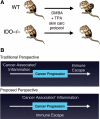Towards a genetic definition of cancer-associated inflammation: role of the IDO pathway
- PMID: 20228228
- PMCID: PMC2861073
- DOI: 10.2353/ajpath.2010.091173
Towards a genetic definition of cancer-associated inflammation: role of the IDO pathway
Abstract
Chronic inflammation drives the development of many cancers, but a genetic definition of what constitutes 'cancer-associated' inflammation has not been determined. Recently, a mouse genetic study revealed a critical role for the immune escape mediator indoleamine 2,3-dioxygenase (IDO) in supporting inflammatory skin carcinogenesis. IDO is generally regarded as being immunosuppressive; however, there was no discernable difference in generalized inflammatory processes in IDO-null mice under conditions where tumor development was significantly suppressed, implicating IDO as key to establishing the pathogenic state of 'cancer-associated' inflammation. Here we review recent findings and their potential implications to understanding the relationship between immune escape and inflammation in cancer. Briefly, we propose that genetic pathways of immune escape in cancer are synonymous with pathways that define 'cancer-associated' inflammation and that these processes may be identical rather than distinct, as generally presumed, in terms of their genetic definition.
Figures


References
-
- Balkwill F, Mantovani A. Inflammation and cancer: back to Virchow? Lancet. 2001;357:539–545. - PubMed
-
- Peek RM, Mohla S, DuBois RN. Inflammation in the genesis and perpetuation of cancer: summary and recommendations from a National Cancer Institute-sponsored meeting. Cancer Res. 2005;65:8583–8586. - PubMed
-
- Dunn GP, Old LJ, Schreiber RD. The immunobiology of cancer immunosurveillance and immunoediting. Immunity. 2004;21:137–148. - PubMed
-
- Koebel CM, Vermi W, Swann JB, Zerafa N, Rodig SJ, Old LJ, Smyth MJ, Schreiber RD. Adaptive immunity maintains occult cancer in an equilibrium state. Nature. 2007;450:903–907. - PubMed
-
- Willimsky G, Blankenstein T. The adaptive immune response to sporadic cancer. Immunol Rev. 2007;220:102–112. - PubMed
Publication types
MeSH terms
Substances
Grants and funding
LinkOut - more resources
Full Text Sources
Other Literature Sources
Research Materials

